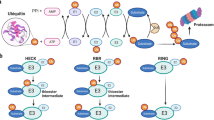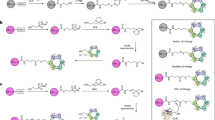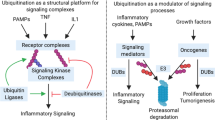Abstract
Owing to the intensive research activity on protein synthesis, little attention was paid in the 1950s and 1960s to protein degradation. However, work by my group and others between 1970 and 1990 led to the identification of the ubiquitin-dependent degradation system. We found that this system contains three types of enzymes: E1 ubiquitin – activating enzyme, E2 ubiquitin – carrier enzyme and E3 ubiquitin – protein ligase. The sequential action of these enzymes leads to conjugation of ubiquitin to proteins and then in most cases to their degradation. This review briefly tells the story of how this pathway was discovered describing the main findings that during the years allowed us to draw the complex picture we have now.
Similar content being viewed by others
Log in or create a free account to read this content
Gain free access to this article, as well as selected content from this journal and more on nature.com
or
Abbreviations
- TAT:
-
tyrosine aminotransferase
- APF-1:
-
ATP-dependent proteolysis factor 1
- cdk:
-
cyclin-dependent kinase
- MPF:
-
M phase-promoting factor
- APC/C:
-
anaphase-promoting complex/cyclosome
- SCF:
-
Skp1-Cuilin1-F-box protein *Nobel Lecture 2004, © The Nobel Foundation 2004
References
Schoenheimer R, Ratner S and Rittenberg D (1939) Studies in protein metabolism. X. The metabolic activity of body proteins investigated with L (−)-leucine containing two isotopes. J. Biol. Chem. 130: 703–732
Schoenheimer R (1942) The Dynamic State of Body Constituents Cambridge, Mass: Harvard University Press
Rabinowitz M and Fisher JM (1964) Biochim. Biophys. Acta 91 91: 313–322
Schimke RT and Doyle D (1970) Control of enzyme levels in animal tissues. Annu. Rev. Biochem. 39: 929–976
Hershko A and Tomkins GM (1971) Studies on the degradation of tyrosine aminotransferase in hepatoma cells in culture. Influence of the composition of the medium and adenosine triphosphate dependence. J. Biol. Chem. 246: 710–714
Simpson MV (1953) The release of labeled amino acids from the proteins of rat liver slices. J. Biol. Chem. 201: 143–154
Hershko A, Ciechanover A and Varshavsky A (2000) The ubiquitin system. Nat. Med. 6: 1073–1081
Hershko A (1996) Lessons from the discovery of the ubiquitin system. Trends Biochem. Sci. 21: 445–449
Wilkinson KD (2004) Essay. Cell 1119: 741–745
Etlinger JD and Goldberg AL (1977) A soluble ATP-dependent proteolytic system responsible for the degradation of abnormal proteins in reticulocytes. Proc. Nati. Acad, Sci. USA 74: 54–58
Ciechanover A, Hod Y and Hershko A (1978) A heat-stable polypeptide component of an ATP-dependent proteolytic system from reticulocytes. Biochem. Biophys. Res. Commun. 81: 1100–1105
Wilkinson KD, Urban MK and Haas AL (1980) Ubiquitin is the ATP-dependent proteolysis factor I of rabbit reticulocytes. J. Biol. Chem. 255: 7529–7532
Goldstein G, Scheid M, Hammerling U, Boyse EA, Schlesinger DH and Niall HD (1975) Isolation of a polypeptide that has lymphocyte-differentiating properties and is probably represented universally in living cells. Proc. Nati. Acad. Sci. USA 72: 11–15
Goldknopf IL and Busch H (1977) Isopeptide linkage between nonhistone and histone 2A polypeptides of chromosomal conjugate-protein A24. Proc. Nati. Acad. Sci. USA 74: 864–868
Ciechanover A, Heller H, Elias S, Haas AL and Hershko A (1980) ATP-dependent conjugation of reticulocyte proteins with the polypeptide required for protein degradation. Proc. Natl. Acad. Sci. USA 77: 1365–1368
Hershko A, Ciechanover A, Heller H, Haas AL and Rose IA (1980) Proposed role of ATP in protein breakdown: conjugation of proteins with multiple chains of the polypeptide of ATP-dependent proteolysis. Proc. Nati. Acad. Sci. USA 77: 1783–1786
Hershko A and Ciechanover A (1998) The ubiquitin system. Annu. Rev. Biochem. 67: 425–479
Ciechanover A, Heiler H, Katz-Etzion R and Hershko A (1981) Activation of the heat-stable polypeptide of the ATP-dependent proteolytic system. Proc. Natl Acad. Sci USA 78: 761–765
Hershko A, Heller H, Elias S and Ciechanover A (1983) Components of ubiquitin-protein ligase system. Resolution, affinity purification, and role in protein breakdown. J. Biol. Chem. 258: 8206–8214
Hershko A, Ciechanover A and Rose IA (1981) Identification of the active amino acid residue of the polypeptide of ATP-dependent protein breakdown. J. Biol. Chem. 256: 1525–1528
Haas AL, Warms JV, Hershko A and Rose IA (1982) Ubiquitin-activating enzyme. Mechanism and role in protein-ubiquitin conjugation. J. Biol. Chem. 257: 2543–2548
Hershko A, Heiler H, Eytan E and Reiss Y (1986) The protein substrate binding site of the ubiquitin-protein ligase system. J. Biol. Chem. 261: 11992–11999
Hershko A (1988) Ubiquitin-mediated protein degradation. J. Biol. Chem. 263: 15237–15240
Evans T, Rosenthal ET, Youngbloom J, Distel D and Hunt T (1983) Cyclin: a protein specified by maternal mRNA in sea urchin eggs that is destroyed at each cleavage division. Cell 33: 389–396
Dorée M and Hunt T (2002) From Cdc2 to Cdk1: when did the cell cycle kinase join its cyclin partner? J. Cell Sci 115: 2461–2464
Luca FC and Ruderman JV (1989) Control of programmed cyclin destruction in a cell-free system. J. Cell Biol. 109: 1895–1909
Hershko A, Ganoth D, Sudakin V, Dahan A, Cohen LH, Luca FC, Ruderman J and Eytan E (1994) Components of a system that ligates cyclin to ubiquitin and their regulation by the protein kinase cdc2 J. Biol. Chem. 269: 4940–4946
Sudakin V, Ganoth D, Dahan A, Heller H, Hershko J, Luca FC, Ruderman JV and Hershko A (1995) Mol. Biol. Cell 6: 185–198
King RW, Peters JM, Tugendreich S, Rolfe M, Hieter P and Kirschner MW (1995) A 20s complex containing CDC27 and CDC16 catalyzes the mitosis-specific conjugation of ubiquitin to cyclin B. Cell 81: 279–288
Irniger S, Piatti S, Michaelis C and Nasmyth K (1995) Genes involved in sister chromatid separation are needed for b-type cyclin proteolysis in budding yeast. Cell 81: 269–277
Zachariae W and Nasmyth K (1999) Whose end is destruction: cell division and the anaphase-promoting complex. Genes Dev. 13: 2039–2058
Peters JM (2002) The anaphase-promoting complex: proteolysis in mitosis and beyond. Mol. Cell 9: 931–943
Bharadwaj R and Yu H (2004) The spindle checkpoint, aneuploidy, and cancer. Oncogene 23: 2016–2027
Slingerland J and Pagano M (2000) Regulation of the Cdk inhibitor p27 and its deregulation in cancer. J. Cell Physiol. 183: 10–17
Pagano M, Tam SW, Theodoras AM, Beer-Romano P, DeI Sal G, Chau V, Yew PR, Draetta GF and Rolfe M (1995) Science 269: 682–685
Montagnoli A, Fiorr F, Eytan E, Carrano AC, Draetta GF, Hershko A and Pagano M (1999) Ubiquitination of p27 is regulated by Cdk-dependent phosphorylation and trimeric complex formation. Genes Dev. 13: 1181–1189
Vlach J, Hennecke S and Amati B (1997) Phosphorylation-dependent degradation of the cyclin-dependent kinase inhibitor p27Kip1. EMBO J. 16: 5334–5344
Deshaies RJ (1999) Scf and Cullin/Ring H2-based ubiquitin ligases. Annu. Rev. Cell Dev. Biol. 15: 435–467
Carrano A, Eytan E, Hershko A and Pagano M (1999) SKP2 is required for ubiquitin-mediated degradation of the CDK inhibitor p27. Nat. Cell Biol. 1: 193–199
Lisztwan J, Marti A, Sutterluti H, Gstaiger M, Wirbelauer C and Krek W (1998) Association of human CUL-1 and ubiquitin-conjugating enzyme CDC34 with the F-box protein p45SKP2: evidence for evolutionary conservation in the subunit composition of the CDC34–SCF pathway. EMBO J. 17: 368–383
Ganoth D, Bornstein G, Ko TK, Larsen B, Tyers M, Pagano M and Hershko A (2001) The cell-cycle regulatory protein Cks1 is required for SCFSkp2-mediated ubiquitinylation of p27. Nat. Cell Biol. 3: 321–324
Harper JW (2001) Curr. Biol. 11: R431–R435
Spruck C, Strohmaier H, Watson M, Smith APL, Ryan A, Krek W and Reed SI (2001) A CDK-independent function of mammalian Cks1: targeting of SCFSkp2 to the CDK inhibitor p27Kip1. Mol. Cell 7: 639–650
Sitry D, Seeliger MA, Ko TK, Ganoth D, Breward SE, Itzhaki LS, Pagano M and Hershko A (2002) J. Biol. Chem. 277: 42233–42240
Richardson HE, Stueland CS, Thomas J, Russet P and Reed SI (1990) Human cDNAs encoding homologs of the small p34Cdc28/Cdc2-associated protein of Saccharomyces cerevisiae and Schizosaccharomyces pombe. Genes Dev. 4: 1332–1344
Bashir T, Dorrello NV, Amador V, Guardavaccaro D and Pagano M (2004) Control of the SCFSkp2–Cks1 ubiquitin ligase by the APC/CCdh1 ubiquitin ligase. Nature 428: 190–193
Acknowledgements
In experimental sciences, including biochemistry, discoveries are not made by a single person, but require the assistance of dedicated research teams and the help of friends, colleagues and collaborators. In my laboratory at the Technion, Haifa, I was very fortunate to receive devoted help, at different times over a period of more than 30 years, from Dvora Ganoth, Hanna Heller, Esther Eytan, Sarah Elias, Clara Segal and from my wife, Judith Hershko. Among my former graduate students, Aaron Ciechanover did tremendous work in the exciting times of the discovery of ubiquitin-protein ligation 25 years ago. Subsequently, many other graduate students (too many to list here) did very important work on the basic biochemistry of the ubiquitin system and more recently, on some roles of this system in cell cycle control. Out of my several friends, collaborators, mentioned in this paper, Irwin Rose had a very special role. My association with Ernie started with a sabbatical year in his laboratory in Fox Chase Cancer Center, Philadelphia, in 1977–1978 (see also accompanying biography). During this year, I continued to work on the initial fractionation of the reticulocyte system and the purification of ubiquitin, which we started in Haifa. In the following summer of 1979, Ernie invited me back to his laboratory, together with my graduate student Aaron Ciechanover and research assistant Hanna Heller. When we got there we already knew, from work done in the Haifa lab, that ubiquitin bound to proteins in an ATP-dependent process. However, the discovery that a covalent amide bond is formed between ubiquitin and the substrate protein was made together with Ernie Rose in that summer in Philadelphia. A group picture, taken at the end of this memorable summer of 1979 at Fox Chase Center, included the people involved (Figure 6). The results of this summer's work were reported in Hershko et al.16 This Review was possible because of kind help of the Nobel Foundation in Stockholm, http://nobelprize.org (© The Nobel Foundation 2004).
At the end of summer of 1979 in Fox Chase Cancer Center, Philadelphia. Seated left to right: Avram Hershko, Sandy Goldman, Jessie Warms, Hanna Heller, Standing left to right: Zelda Rose, Arthur Haas, Aaron Ciechanover, Mary Williamson, Irwin Rose, Keith Wilkinson and Leonard Cohen (last three people standing on the right side not identified)
Author information
Authors and Affiliations
Corresponding author
Additional information
Edited by G Melino
Nobel Lecture 2004, © The Nobel Foundation 2004
Rights and permissions
About this article
Cite this article
Hershko, A. The ubiquitin system for protein degradation and some of its roles in the control of the cell division cycle. Cell Death Differ 12, 1191–1197 (2005). https://doi.org/10.1038/sj.cdd.4401702
Received:
Accepted:
Published:
Issue date:
DOI: https://doi.org/10.1038/sj.cdd.4401702
Keywords
This article is cited by
-
Rational design and development of novel NAE inhibitors for the treatment of pancreatic cancer
Medicinal Chemistry Research (2023)
-
Ubiquitin-specific protease 35 (USP35) mediates cisplatin-induced apoptosis by stabilizing BIRC3 in non-small cell lung cancer
Laboratory Investigation (2022)
-
Revealing β-TrCP activity dynamics in live cells with a genetically encoded biosensor
Nature Communications (2022)
-
Proteomic analysis identifies mechanism(s) of overcoming bortezomib resistance via targeting ubiquitin receptor Rpn13
Leukemia (2021)
-
Selective inhibition of cullin 3 neddylation through covalent targeting DCN1 protects mice from acetaminophen-induced liver toxicity
Nature Communications (2021)




